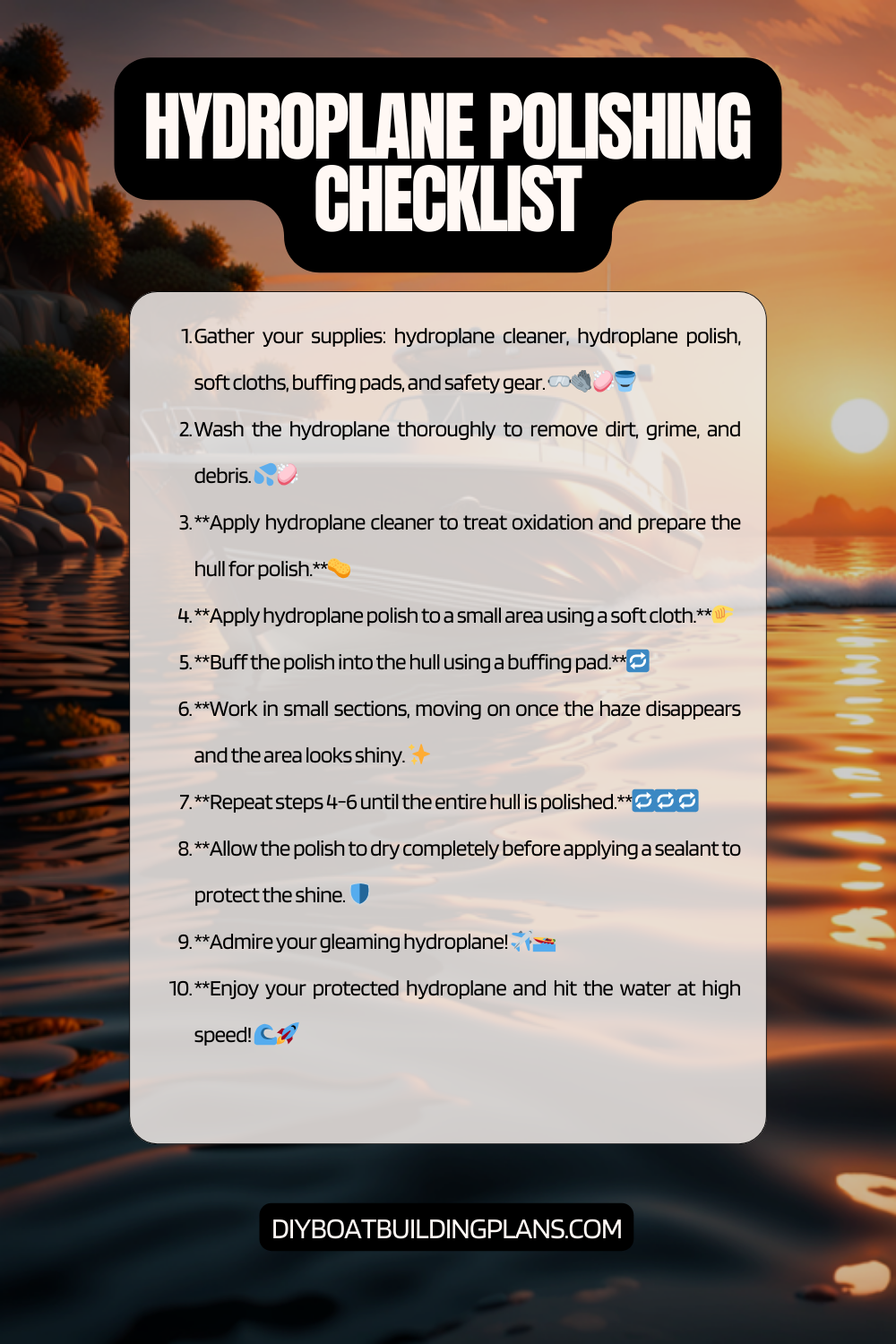Overview of Hydroplane Polishing Tips
Hydroplane polishing is a process that involves restoring and maintaining the polished surface of hydroplanes. Hydroplanes are high-performance boats that are designed to skim across the water at high speeds. Maintaining a polished surface on these boats is crucial for both aesthetic and functional reasons. A polished surface not only enhances the overall appearance of the hydroplane but also improves its performance on the water.
Key Takeaways
- Hydroplane polishing is important for maintaining the appearance and performance of your boat.
- Choosing the right polishing products and preparing the surface properly are key to achieving a perfect finish.
- Common mistakes to avoid include using too much pressure and not allowing enough time for the polish to dry.
- Regular maintenance is necessary to keep the polished surface looking its best.
- Professional polishing services can save time and ensure a high-quality finish.

Understanding the Importance of Hydroplane Polishing
There are several benefits to hydroplane polishing that make it an essential part of boat maintenance. Firstly, a polished surface reduces drag, allowing the hydroplane to glide through the water more efficiently. This can result in increased speed and improved fuel efficiency. Additionally, a polished surface helps to prevent the build-up of algae, barnacles, and other marine organisms, which can negatively impact the hydroplane’s performance.
Furthermore, hydroplane polishing helps to protect the boat’s exterior from damage caused by exposure to saltwater, UV rays, and other environmental factors. The polishing process creates a protective barrier that shields the hydroplane’s surface from corrosion, fading, and oxidation. By regularly polishing the hydroplane, owners can extend its lifespan and maintain its value over time.
Choosing the Right Polishing Products for Hydroplanes
When it comes to choosing the right polishing products for hydroplanes, there are several options available on the market. It is important to consider factors such as the type of material used in the construction of the hydroplane, personal preferences, and budget constraints.
There are different types of polishing products available, including compounds, polishes, and waxes. Compounds are used to remove scratches and imperfections from the surface of the hydroplane. Polishes are used to restore shine and luster to the boat’s exterior. Waxes provide a protective layer that helps to maintain the polished finish.
It is crucial to select products that are specifically designed for use on hydroplanes. These products are formulated to withstand the harsh marine environment and provide long-lasting protection. Reading product labels, researching customer reviews, and seeking recommendations from professionals can help in making an informed decision.
Preparing the Hydroplane for Polishing
| Task | Time Required | Tools Needed | Materials Needed |
|---|---|---|---|
| Wash the Hydroplane | 30 minutes | Bucket, sponge, soap | Water, soap |
| Dry the Hydroplane | 20 minutes | Towels, chamois | N/A |
| Inspect for Damage | 15 minutes | Flashlight, magnifying glass | N/A |
| Remove Stains and Scratches | 1 hour | Polishing compound, buffer, pads | N/A |
| Apply Wax | 30 minutes | Wax, applicator pad | N/A |
Before starting the polishing process, it is important to thoroughly clean the surface of the hydroplane. This involves removing any dirt, grime, or salt residue that may have accumulated. Using a mild detergent and a soft brush, gently scrub the entire surface of the hydroplane. Rinse thoroughly with clean water to ensure all traces of soap are removed.
In addition to cleaning, it is necessary to remove any existing wax or polish from the hydroplane’s surface. This can be done using a specialized wax remover or a mixture of vinegar and water. Apply the remover or vinegar solution to a clean cloth and gently rub it onto the surface in circular motions. This will help to strip away any old wax or polish, allowing for a fresh start.
Step-by-Step Guide to Hydroplane Polishing
To achieve a perfect finish on a hydroplane, follow these step-by-step instructions:
1. Start by applying a small amount of compound to a clean polishing pad.
2. Working in small sections, apply the compound to the surface of the hydroplane using circular motions.
3. Continue polishing until the scratches and imperfections are removed.
4. Once the desired results are achieved, wipe away any excess compound with a clean microfiber cloth.
5. Next, switch to a clean polishing pad and apply a small amount of polish.
6. Using the same circular motion, apply the polish to the surface of the hydroplane.
7. Continue polishing until a high-gloss shine is achieved.
8. Finally, apply a thin layer of wax using a clean cloth or applicator pad.
9. Allow the wax to dry according to the manufacturer’s instructions.
10. Once dry, buff the waxed surface with a clean microfiber cloth to reveal a brilliant shine.
It is important to note that the polishing process should be done in a shaded area to prevent the products from drying too quickly and leaving behind residue. Additionally, it is recommended to work in small sections to ensure even coverage and avoid missing any spots.
Common Mistakes to Avoid During Hydroplane Polishing
While hydroplane polishing can yield excellent results, there are some common mistakes that should be avoided to prevent damage to the boat’s surface. One common mistake is using too much pressure when applying the compound or polish. Applying excessive pressure can cause swirl marks and scratches, defeating the purpose of polishing.
Another mistake is using the wrong type of polishing pad. It is important to choose a pad that is appropriate for the specific product being used. Using a pad that is too abrasive can result in damage to the hydroplane’s surface, while using a pad that is too soft may not provide enough polishing action.
Furthermore, neglecting to properly clean and prepare the hydroplane before polishing can lead to subpar results. It is crucial to remove any dirt, grime, or old wax before starting the polishing process. Failure to do so can result in uneven polishing and reduced effectiveness of the products used.
Tips for Achieving a Perfect Finish on Hydroplanes
In addition to following the step-by-step guide, there are some additional tips that can help achieve a flawless finish on hydroplanes. Firstly, it is important to work in small sections and avoid rushing through the process. Taking the time to properly polish each section will yield better results.
Secondly, using high-quality products and tools can make a significant difference in the outcome of the polishing process. Investing in reputable brands and professional-grade equipment will ensure better performance and longer-lasting results.
Lastly, regular maintenance and touch-ups are key to maintaining the polished surface of hydroplanes. By regularly washing and waxing the boat, owners can prevent the build-up of dirt and grime, making future polishing sessions easier and more effective.
Maintaining the Polished Surface of Hydroplanes
To keep a hydroplane looking polished and well-maintained, it is important to establish a regular maintenance schedule. This includes washing the boat with a mild detergent and clean water after each use to remove any salt or debris. Additionally, applying a fresh coat of wax every few months will help to protect the polished surface and maintain its shine.
It is also recommended to store the hydroplane in a covered area or use a boat cover when not in use. This will protect the boat from exposure to UV rays, rain, and other environmental factors that can cause damage or fading.
Download over 500 Boat Plans. Click on the link below.
-->Click Here<--
Polishing Safety Precautions for Hydroplanes
When undertaking any polishing project, it is important to prioritize safety. When polishing a hydroplane, it is recommended to wear protective gear such as gloves and safety glasses to prevent any potential injuries. Additionally, working in a well-ventilated area is crucial to avoid inhaling fumes from the polishing products.
It is also important to read and follow the instructions provided by the manufacturer for each product used. Some products may have specific safety precautions or application guidelines that should be followed for optimal results and safety.
Benefits of Professional Hydroplane Polishing Services
While DIY hydroplane polishing can be rewarding, there are several advantages to hiring a professional polishing service. Firstly, professionals have extensive experience and knowledge in working with different types of hydroplanes and can provide expert advice on the best products and techniques for achieving optimal results.
Professional polishing services also have access to specialized equipment and tools that may not be readily available to individuals. This allows them to achieve a higher level of precision and efficiency in their work.
Furthermore, hiring a professional saves time and effort. Polishing a hydroplane can be a time-consuming and physically demanding task, especially for larger boats. By outsourcing the job to professionals, owners can focus on other aspects of boat maintenance or simply enjoy their time on the water.
Hydroplane Polishing Checklist

Conclusion – Hydroplane Polishing Tips
In conclusion, hydroplane polishing is a crucial aspect of boat maintenance that should not be overlooked. By maintaining a polished surface, hydroplane owners can enjoy improved performance, increased fuel efficiency, and enhanced aesthetics. Choosing the right polishing products, following proper techniques, and avoiding common mistakes are key to achieving a perfect finish.
Regular maintenance and touch-ups are essential for preserving the polished surface of hydroplanes. By establishing a maintenance schedule and following recommended practices, owners can ensure that their hydroplanes remain in top condition for years to come.
Whether opting for DIY polishing or hiring a professional service, it is important to prioritize safety and use appropriate protective gear. Following safety precautions and reading product instructions will help ensure a successful and safe polishing experience.
In conclusion, hydroplane polishing is an investment that pays off in terms of improved performance, longevity, and overall enjoyment of the hydroplane. By following the tips and guidelines outlined in this article, hydroplane owners can achieve a flawless finish and maintain their boats in pristine condition.
FAQs – Hydroplane Polishing Tips
What is hydroplane polishing?
Hydroplane polishing is a technique used to remove scratches, swirls, and other imperfections from the surface of a boat or other watercraft using a high-speed rotary buffer and a specialized polishing compound.
What are the benefits of hydroplane polishing?
Hydroplane polishing can restore the shine and luster of a boat’s gelcoat or paint, making it look like new again. It can also help protect the surface from UV damage and other environmental factors.
What tools and materials are needed for hydroplane polishing?
To perform hydroplane polishing, you will need a high-speed rotary buffer, a variety of polishing pads, a specialized polishing compound, and a clean microfiber towel.
What are some tips for achieving the best results with hydroplane polishing?
Some tips for achieving the best results with hydroplane polishing include using the right polishing pad for the job, working in small sections, using a slow and steady hand, and keeping the surface lubricated with water or a specialized polishing spray.
Is hydroplane polishing safe for all types of boats?
Hydroplane polishing is generally safe for all types of boats, but it is important to use the right polishing compound and pad for the specific type of surface you are working on. It is also important to avoid applying too much pressure or working too aggressively, as this can cause damage to the surface.



